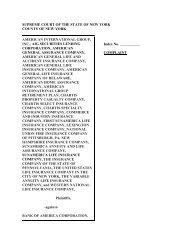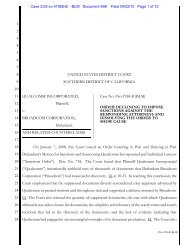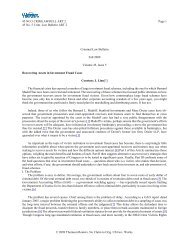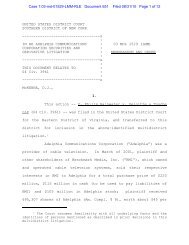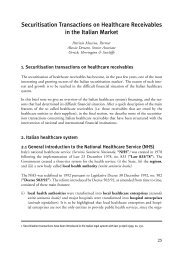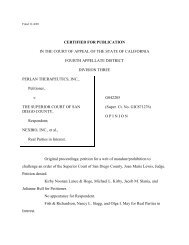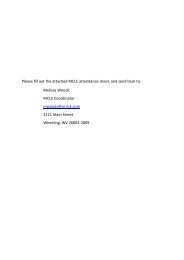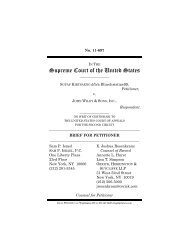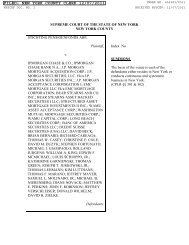Download
Download
Download
You also want an ePaper? Increase the reach of your titles
YUMPU automatically turns print PDFs into web optimized ePapers that Google loves.
A Hot, Flat, Crowded World<br />
As Thomas L. Friedman points out in his latest bestseller, the world has a serious problem:<br />
It is getting hot, flat, and crowded. That is, global warming, the stunning rise of<br />
middle classes all over the world, and rapid population growth have converged in<br />
a way that could make our planet dangerously unstable. In particular, the<br />
convergence of hot, flat, and crowded is tightening energy supplies, intensifying<br />
the extinction of plants and animals, deepening energy poverty, strengthening<br />
petro-dictatorship, and accelerating climate change. 1<br />
The inauguration of President Barack Obama creates an opportunity for dramatic changes in U.S.<br />
energy and environmental policy, which could position our country to lead the charge in solving<br />
the world’s “hot, flat, and crowded” problem. As Friedman notes, tackling this challenge presents<br />
a tremendous opportunity, and taking it on “will revive America at home, reconnect America<br />
abroad, and retool America for tomorrow.” 2<br />
President Obama recognizes the “hot, flat, and crowded” problem, and the opportunity for the<br />
U.S. to be the leader in taking it on. He has stated consistently that creating a clean energy<br />
economy is going to be a top priority of the Obama Administration, and if he follows through on<br />
his vow – and to date he already has taken a number of concrete steps indicating he has every<br />
intention of doing so – the next four years and beyond will be the beginning of dramatic growth for<br />
the clean energy, or cleantech, industry. As the old industrial, fossil fuel-driven era is replaced by<br />
the new clean energy economy, it will be critical for cleantech companies to understand the<br />
power of intellectual property rights and how they can be used in spurring innovation, attracting<br />
financing, capturing and defending growing markets, and increasing revenues.<br />
A Sound Investment<br />
The current economic crisis unquestionably has cast a slight cloud over cleantech. With credit<br />
markets frozen, financing for capital-intensive projects has become much harder to secure, and<br />
venture capitalists are asking companies they are financing to cut back on costs in an attempt to<br />
ride out the storm. For example, Think Global and Tesla Motors are delaying their muchanticipated<br />
rollouts of electric cars in the U.S.. 3 Even billionaire T. Boone Pickens is postponing<br />
his plans to build the world’s largest wind farm. 4<br />
Cleantech start-ups nevertheless were able to raise $1.7 billion worldwide in the fourth quarter of<br />
2008, 5 representing only a 4 percent decrease from the same quarter a year ago. 6 American<br />
cleantech start-ups raised a record $5.8 billion in 2008, up 56 percent from 2007. 7 This resilience<br />
in the face of an unprecedented financial crisis bodes well for the future of the cleantech industry,<br />
particularly in view of the Obama Administration’s commitment to creating a clean energypowered<br />
economy.<br />
Venture capitalists and other financiers are excited about the clean energy economy. John Doerr<br />
of venture capital firm Kleiner Perkins Caufield & Byers in Silicon Valley, which backed Google<br />
and Amazon in their early days, describes cleantech as “the biggest economic opportunity of the<br />
21st century.” 8 A November 2008 Merrill Lynch study calls cleantech the “Sixth Technology<br />
Revolution,” and predicts it will usher in a “golden age” rivaling the impact of the Industrial<br />
Revolution, and the Information and Telecommunications Revolution. 9<br />
While other industries are floundering, the current recession has actually triggered fast-tracked<br />
legislation and government programs that will ensure immediate opportunities and long-term<br />
growth in the cleantech sector, as President Obama highlighted recently when signing the<br />
American Recovery and Reinvestment Act of 2009 10 in Denver:<br />
Because we know we can’t power America’s future on energy that’s controlled by<br />
foreign dictators, we are taking a big step down the road to energy<br />
1
Obama’s Plan<br />
independence, and laying the groundwork for a new, green energy economy that<br />
can create countless well-paying jobs. It’s an investment that will double the<br />
amount of renewable energy produced over the next three years, and provide tax<br />
credits and loan guarantees to companies like Namaste Solar, a company that<br />
will be expanding, instead of laying people off, as a result of the plan I am<br />
signing.<br />
In the process we will transform the way we use energy. . . . The investment we<br />
are making today will create a newer, smarter electric grid that will allow for the<br />
broader use of alternative energy. . . . And it’s an investment that takes the<br />
important first step towards a nationwide [energy transmission] superhighway<br />
that will connect our cities to the windy plains of the Dakotas and the sunny<br />
deserts of the Southwest. 11<br />
President Obama recognizes the important role government can play in leading the country into<br />
the new clean energy economy:<br />
[T]hink of what’s happening in countries like Spain, Germany and Japan, where<br />
they’re making real investments in renewable energy. They’re surging ahead of<br />
us, poised to take the lead in these new industries. This isn’t because they’re<br />
smarter than us, or work harder than us, or are more innovative than we are. It’s<br />
because their governments have harnessed their people’s hard work and<br />
ingenuity with bold investments—investments that are paying off in good, highwage<br />
jobs—jobs they won’t lose to other countries. There is no reason we can’t<br />
do the same thing right here in America. 12<br />
The Obama Administration therefore intends to move forward quickly with implementing and<br />
investing in an energy plan that will allow the U.S. to lead in transforming the way the world<br />
generates, distributes, and uses energy. The President emphasized this recently before a Joint<br />
Session of Congress:<br />
We know the country that harnesses the power of clean renewable energy will<br />
lead the 21st century. And yet, it is China that has launched the largest effort in<br />
history to make their economy energy efficient. We invented solar technology,<br />
but we’ve fallen behind countries like Germany and Japan in producing it. New<br />
plug-in hybrids roll off our assembly lines, but they will run on batteries made in<br />
Korea. Well I do not accept a future where the jobs and industries of tomorrow<br />
take root beyond our borders—and I know you don’t either. It’s time for America<br />
to lead again. 13<br />
The President’s “New Energy for America” plan and budget calls for the federal government to<br />
invest at least $150 billion in clean energy over the next 10 years. 14 The budget will build on<br />
efforts in the Recovery and Reinvestment Act to direct tens of billions of dollars toward creating a<br />
new, smarter electric grid having the capacity for transmitting clean energy from where it is<br />
generated to where it is needed. 15 The President plans on raising fuel efficiency standards,<br />
providing tax rebates for plug-in hybrid vehicles, requiring 10 percent of electricity to come from<br />
renewables by 2012, and implementing an economy-wide cap-and-trade program to reduce<br />
greenhouse gas (GHG) emissions. 16<br />
Also exciting are the Obama Administration’s proposals for research and commercialization. The<br />
President plans on doubling federal science and research funding for clean energy projects, 17 and<br />
making the Research and Experimentation Tax Credit permanent, so companies embracing the<br />
move toward alternative energy can rely on the credit when making decisions to invest in<br />
domestic R&D over long periods of time. 18 To ensure that clean energy innovations progress<br />
2
eyond the laboratory, Obama proposes creating a $50 billion Clean Technologies Deployment<br />
Venture Capital Fund (CTDVCF).<br />
Successful implementation of the President’s energy plan will depend on bringing all Americans<br />
onboard as stakeholders in the new energy economy. A biofuel initiative will help bring<br />
agricultural communities on board. Proposed federal grant and job training programs are<br />
designed to create jobs in states hit hard by the loss of manufacturing jobs, building upon<br />
success stories like that of Cardinal Fastener in Ohio. President Obama has pointed to this<br />
company as an example of how focusing on opportunities in clean energy can have real, tangible<br />
benefits:<br />
The story of this company—which began building wind turbine parts just two<br />
years ago, and is now poised to make half its earnings that way—is that a<br />
renewable energy economy isn’t some pie-in-the-sky, far-off future. It’s<br />
happening all across America right now. It’s providing alternatives to foreign oil<br />
now. It can create millions of additional jobs and entire new industries if we act<br />
right now. 19<br />
Land Of Opportunity<br />
The U.S. is the ideal location for clean energy innovation. A June 2008 study from the RAND<br />
Institute found that 40 percent of the world’s spending on scientific research and development<br />
comes from the U.S. alone. 20 America employs 70 percent of the world’s Nobel Prize winners,<br />
and is home to 75 percent of the world’s top 40 universities. 21 “The United States is still the world<br />
leader in science and technology,” says the study’s coauthor, James Hosek. 22 A 2008 Deloitte<br />
LLP survey of venture capitalists from around the world echoes this belief, finding that the U.S.<br />
remains an unmatched leader in innovation across technology sectors, from software to<br />
cleantech. 23 President Obama appears committed to ensuring the U.S. maintains this leadership<br />
position, offering words of encouragement and promises of support to a group of clean energy<br />
entrepreneurs visiting the White House recently:<br />
. . . innovators like you are creating the jobs that will foster our recovery –- and<br />
creating the technologies that will power our long-term prosperity. So I thank you<br />
for your work. It's said that necessity is the mother of invention. At this moment of<br />
necessity, we need you. We need some inventiveness. Your country needs you<br />
to create new jobs and lead new industries. Your country needs you to mount a<br />
historic effort to end once and for all our dependence on foreign oil. And in this<br />
difficult endeavor -- in this pursuit on which I believe our future depends -- your<br />
country will support you. Your President will support you. 24<br />
The U.S. is also the ideal location for commercialization of clean energy technology. American<br />
cleantech companies currently account for almost 70 percent of worldwide cleantech venture<br />
capital investment. 25<br />
Most importantly, the U.S. provides the strongest intellectual property protection for the largest<br />
and most prosperous market in the world for energy consumption. Indeed, one of the reasons for<br />
the relatively limited investment of venture capital in cleantech in rapidly developing countries like<br />
China and India is the lack of robust and tested intellectual property protection. 26<br />
The Clean Energy Patent Landscape<br />
The clean energy patent landscape is now relatively open and collaborative, with little patent<br />
litigation compared to more mature industries like the software or semiconductor industries. As<br />
the market for clean energy technology grows, however, and the financial stakes increase,<br />
companies are likely to move away from this open and collaborative mind-set, looking for ways to<br />
3
grow market share or revenues in an increasingly competitive environment. This is where<br />
adapting and following-through on intelligent strategies to develop and protect intellectual<br />
property becomes critical to success.<br />
The Importance of a Strong Patent Portfolio<br />
Generally, a strong patent portfolio will be a clean energy company’s main asset because the<br />
company is focusing on developing innovations and ideas, rather than tangible products. 27 Even<br />
where actual products are being developed, cleantech companies regularly focus on R&D,<br />
partnering with larger companies to get the products manufactured under license.<br />
A well-developed portfolio of patents or pending patent applications can be key to securing<br />
financing for an emerging cleantech company. Compared to other sectors, clean energy<br />
innovations often require a larger amount of capital and a longer time for development. For<br />
instance, a software start-up may require only hundreds of thousands of dollars for computer<br />
equipment and a handful of developers to develop a working product in a year or less. By<br />
contrast, a solar start-up’s thin film technology for laying silicon on a substrate may require<br />
hundreds of millions of dollars and many years for prototyping and manufacturing before a viable<br />
product ever reaches market. Because of these different stakes, venture capitalists in other<br />
sectors can afford to be focused on time-to-market, but venture capitalists in the cleantech sector<br />
must be certain the essence of their investment—the intellectual property of the company—is<br />
protected properly. 28<br />
Fostering a Culture of Innovation<br />
To thrive in the clean energy economy, cleantech companies must develop and encourage a<br />
culture of innovation. Employees should be motivated to think creatively, and be educated about<br />
the importance of innovating and obtaining patents. Companies of all sizes should consider<br />
establishing programs that recognize and reward creativity—particularly where it results in<br />
inventions and patents. A recent survey published by ipPerformance Group finds that companies<br />
having incentive programs for employee inventions are home to far more innovative work than<br />
companies without such programs. 29<br />
Regular employee innovation brainstorming sessions also should be encouraged. Since<br />
cleantech innovations often involve the melding of principles from traditionally separate areas of<br />
science and engineering, clean energy companies should make every effort to include employees<br />
with diverse technical backgrounds in brainstorming sessions. Someone with a background in<br />
chemistry or biology, for example, may offer fresh insights and ideas to a team of electrical<br />
engineers and computer scientists struggling to come up with an innovative solution to a problem<br />
a smart grid start-up is struggling to solve. If possible, patent attorneys should be invited to attend<br />
or review the results of every brainstorming session. Invention company Intellectual Ventures<br />
does this, and reportedly generated 500 patent applications over the course of just 70<br />
brainstorming sessions. 30<br />
Incremental Inventions<br />
As Secretary of Energy Steven Chu said in a recent interview, solving the world’s “hot, flat, and<br />
crowded” problem is going to require revolutionary, Nobel-level breakthroughs in science and<br />
technology. 31 Every cleantech company therefore needs to be “thinking big” when innovating.<br />
When formulating a patent strategy in the clean energy sector, however, it is important to<br />
remember that not only groundbreaking or revolutionary inventions are patentable; incremental<br />
innovations based on existing technology may also be patentable and commercially valuable. 32<br />
Thomas Edison understood this principle, and many of his most valuable patents were for<br />
incremental inventions. His patented light bulb, for example, was an incremental improvement<br />
upon an incandescent electric lamp developed 20 years earlier by another inventor, Joseph<br />
Swan. 33<br />
4
Failing to obtain patent protection for merely incremental improvements is risky, and may result in<br />
lost opportunities of tremendous value. In the clean energy sector, for example, it has long been<br />
known that a wind turbine consists of a rotor, gearbox, generator, and blades. A variable-speed<br />
generator may be an incremental improvement over a fixed-speed generator. Swept blades may<br />
be an incremental improvement over linear blades. 34 While the basic idea of a wind turbine itself<br />
is not patentable, having been known and used for years, 35 new and related incremental<br />
inventions should not be overlooked.<br />
Patents directed at incremental improvements in efficiency and profitability of existing energy<br />
technologies are a good example. As Carl Horton, Chief Intellectual Property Officer at General<br />
Electric, notes, “anyone can go out and make a basic turbine. That can be done freely. It’s the<br />
things that are making them more efficient, more profitable that are on patent.” 36 Jesus Alonso, a<br />
Research and Development Director at Isofoton, one of the world’s leading photovoltaic<br />
companies, similarly says, “[a]ny good scientific book will tell you how to make a solar cell. What<br />
is complex [and valuable] is the know-how required to make it more efficient, cheaper, in higher<br />
quantities, and better quality.” 37<br />
A collection of incremental inventions together may represent an important and strategic value<br />
chain. Consider the previous example of variable-speed generators and swept blades for wind<br />
turbines. Even if each incremental invention alone only slightly improves performance, the<br />
efficiencies of the improvements combined could allow wind power in a particular region to reach<br />
“grid parity,” i.e., the point where electricity from the wind (or the sun or any other clean energy<br />
source) meets or beats the price of using carbon-based fuels like coal or natural gas.<br />
Enabling and Interface Technologies<br />
How diverse technologies work together at particular interface points may be separately<br />
patentable, beyond any protection available for the core technologies associated with a given<br />
clean energy innovation. 38 With the Obama Administration committed to modernizing America’s<br />
power grid, there may be many opportunities to develop valuable inventions at the interface<br />
between generating clean energy and transmitting it to the end users.<br />
For example, a wind turbine company may own many core inventions associated with wind<br />
power. However, the company’s most valuable invention could be one for interfacing with other<br />
technologies, and not one specifically associated with wind power. Consider an invention<br />
connecting a wind farm’s fluctuating power output to an electric grid without causing frequency<br />
and voltage-related problems. Valuable patent claims to this invention conceivably could be<br />
written to transcend wind power by covering the interface between an electric grid and any<br />
fluctuating clean energy source (whether that source is wind, solar, geothermal, or wave power).<br />
As another example of interfacing technology, consider an auto company or a biofuel producer.<br />
At low temperatures, engines can have biofuel gelling problems. 39 An innovation solving the<br />
viscosity problem at this juncture between biofuel and engine technologies could be a key<br />
enabling technology. Inventions relating to technological interfaces may give rise to some of the<br />
most valuable patents in the clean energy sector.<br />
Energy Storage Technologies<br />
Energy storage will be a fundamental enabling technology in the clean energy economy. 40<br />
Powering hybrid electric vehicles, smoothing out fluctuations in electricity supply and demand,<br />
and extending appliance functionality all require energy storage technology. 41 Of particular<br />
importance are high-power storage technologies directed at achieving grid parity. Energy<br />
management applications implementing these technologies improve price performance by<br />
making electricity more dispatchable, and by addressing load leveling, peak shaving, and<br />
arbitrage issues. Innovations addressing energy storage and management issues will become<br />
particularly valuable as the Obama Administration follows through on its plan for investing in the<br />
development of a modern, smart electric grid.<br />
5
Carbon Capture and Sequestration<br />
Many countries, including the U.S., China, and India, are likely to continue for years relying on<br />
coal for base-load electrical power. Developing increasingly efficient and effective carbon capture<br />
and sequestration technologies, therefore, will be critical if we are to meet our goals of restricting<br />
and reducing carbon dioxide emissions. Clean energy innovators should be seeking out<br />
opportunities for developing and patenting inventions in this field.<br />
Emissions Measuring and Trading<br />
Innovations in trading emissions credits or measuring GHG emissions also represent areas of<br />
opportunity. Under a carbon cap-and-trade system, lower emissions companies may sell carbon<br />
credits to higher emissions companies that would otherwise exceed their emission caps.<br />
President Obama has promised to implement an economy-wide cap-and-trade program aimed at<br />
reducing GHG emissions, and a number of studies predict the value of the carbon trading market<br />
in the U.S. will reach $1 trillion per year by 2020. 42 A recent report finds a significant upward trend<br />
in inventions relating to methods for trading emissions, with patents issuing to, among others,<br />
U.S. mortgage finance company Fannie Mae, who patented a system for trading GHG reduction<br />
credits earned by homeowners. 43 Clean energy companies should be focused on developing and<br />
staking out claims for measuring emissions and for trading emissions credits.<br />
Reviewing the Patents of Others<br />
A wealth of information can be obtained by studying clean energy patents owned by others. Such<br />
patents can be springboards for patentable improvements or design alternatives. For years, many<br />
companies refused to look at patents owned by others, fearful of possibly triggering liability for<br />
willful patent infringement in a U.S. lawsuit. These fears should be less of a concern now, since<br />
the Federal Circuit in Seagate made it harder to establish willful infringement. 44<br />
Being aware of the patent landscape will help an innovative company avoid investing time and<br />
money developing technology only to later learn that the technology has already been patented<br />
by a competitor. One must keep in mind, however, that many pending patent applications are<br />
unavailable to the public until they are published, or in some cases until they issue as patents, so<br />
one can never assume having total knowledge of the landscape.<br />
Prosecution Strategies<br />
There are several important strategies for clean energy companies to consider when turning to<br />
the particulars of patent prosecution.<br />
Where To File<br />
Decisions on where to file a patent application should take into account which countries will have<br />
significant markets for products embodying the invention, and which countries will produce the<br />
products. In cleantech, a likely answer on both counts is the U.S., particularly in view of President<br />
Obama’s commitment to leading the country into the 21st century clean energy economy, and to<br />
ensuring that the green collar jobs associated with that economy stay within our borders.<br />
Filing for patent protection first in the U.S. gives applicants opportunities for excluding potential<br />
prior art by taking advantage of our “first to invent” system, which is different from the “first to file”<br />
system used in most other countries. In a “first to file” system, prior art includes all art existing<br />
prior to the filing date of a patent application. By contrast, in the U.S. “first to invent” system, prior<br />
art includes all art existing prior to the date of invention claimed in a patent application. 45 Because<br />
an applicant’s invention date may occur well in advance of the filing of a patent application, the<br />
scope of potentially invalidating prior art may be narrowed significantly. In an environment where<br />
many clean energy companies around the globe are likely working on closely related innovations,<br />
this narrowing of the scope of potential prior art could be invaluable.<br />
6
The location of key clean energy competitors should also be a factor in deciding where, in<br />
addition to the U.S., to file patent applications. William Pledger, Chief Engineer at fuel cell<br />
company IdaTech in Oregon says, “[w]e look at where our competitors are and we may try to get<br />
patent protection outside the U.S. You try to get as much patent protection as you can, whether<br />
it’s simply for protection or as a potential bargaining chip.” 46<br />
Filing for patent protection in China is critical because of its fast-growing demand for clean<br />
energy. China’s cleantech sector continues to grow and enjoy steady capital inflow despite the<br />
current global economic crisis. 47 The Chinese government has set a renewable energy budget of<br />
at least USD$293 billion for the next 12 years and is on track to obtain 15 percent of its energy<br />
from renewable sources by 2020. 48<br />
Term Extensions<br />
A cleantech company should consider ways for increasing the chances that the U.S. Patent and<br />
Trademark Office (USPTO) will grant a term extension upon issuing a patent. Clean energy<br />
product development cycles typically are long, and many clean energy patents may not have true<br />
commercial value until decades after the filing of the underlying patent applications. Because the<br />
20-year term of a U.S. patent starts running the day the patent application is filed, 49 any term<br />
extension will extend the life of the patent into the future when the market for the patented<br />
invention hopefully will be huge.<br />
Cleantech’s multidisciplinary nature may increase the chances of being granted a valuable term<br />
extension. The USPTO is divided into various divisions according to technology, with different<br />
divisions processing patent applications at widely varying rates. An applicant might consider<br />
characterizing his or her cleantech innovation to correspond with the technology associated with<br />
the slowest processing USPTO division because, under certain circumstances, a slow<br />
examination may result in the granting of a term extension. 50<br />
Accelerating Examination<br />
There may be situations where the market for a cleantech invention already is so robust that the<br />
owner will want a patent to issue as quickly as possible. The term of a U.S. patent is 20 years<br />
from the date the application is filed. 51 Therefore, shortening the time between filing the<br />
application and issuance of the patent can effectively extend the useful life of the issued patent.<br />
On average, it takes nearly 32 months to obtain a U.S. patent. 52 Reducing this time could lessen<br />
the cost of prosecuting the patent and enable a clean energy patent owner to start earning money<br />
sooner from market exclusivity or from licensing the issued patent. One option for reducing the<br />
prosecution time is taking advantage of the USPTO’s Accelerated Examination Program, which<br />
allows certain types of patent applications (including applications relating to clean energy<br />
innovations) to get moved forward in the examination queue. The program’s target examination<br />
time is 12 months. 53<br />
Defensive Publication<br />
If a cleantech company cannot afford to patent every one of its inventions, it should instead<br />
consider publishing the inventions to establish them as prior art. Publication should prevent<br />
competitors from patenting the inventions themselves and then using the patents down the road<br />
to interfere with the business of the cleantech company that decided not to seek patent<br />
protection.<br />
Keeping Related Applications Pending<br />
Companies seeking patent protection for their innovations always run the risk of competitors<br />
trying to design around the patent. Any patent applicant, cleantech or not, should try keeping<br />
related applications pending long after an original application issues as a patent. Related<br />
7
applications are those filed after an original application is filed, but before the original application<br />
issues as a patent, and that involve similar or related technologies. 54 The benefit is that if a<br />
competitor somehow successfully designs around the issued patent, the claims of the related<br />
application may be modified during prosecution in a way that covers the competitor’s designaround.<br />
Strategic Acquisition<br />
Clean energy companies should also consider reinforcing their intellectual property portfolios by<br />
strategically acquiring patents from others. Universities and research institutes can be sources of<br />
valuable inventions and patents. Invention company Intellectual Ventures recognizes this, having<br />
in recent years acquired rights to a myriad of inventions and patents spanning the technological<br />
spectrum from more than 80 universities around the world. 55 Attending patent auctions organized<br />
by intellectual property brokerage companies like Ocean Tomo, or participating in an online<br />
auction of “green” patents like those offered by LynxStreet.com, may also be time well spent as<br />
patent owners unable or unwilling themselves to commercialize their own clean energy inventions<br />
take advantage of the increasingly thriving marketplace for patents.<br />
Licensing<br />
A broad and deep portfolio of clean energy patents can lead to significant revenue from licensing.<br />
Ernst & Young expects worldwide revenue from patent licensing to reach $500 billion by 2015, up<br />
dramatically from $110 billion in 2000. 56 Cleantech companies also should proactively use their<br />
patent portfolios as leverage to share in the technical innovations of others via cross-licensing<br />
deals. 57 Companies using their portfolios in this collaborative manner will be rewarded with a<br />
greater freedom to operate and innovate, while remaining competitors are left in the position of<br />
trying to design around a wall of cross-licensed patent portfolios.<br />
Manufacturing cleantech products is particularly capital intensive. Clean energy start-ups focusing<br />
on innovating should consider licensing arrangements with larger companies to help bring the<br />
inventions to market. Larger companies have greater financial, marketing, distribution, and<br />
manufacturing resources, and often more extensive regulatory knowledge. Another reason for<br />
considering licensing arrangements with a larger firm is because it will give the larger company a<br />
financial interest in protecting the invention. 58 Would-be infringers may be deterred, and<br />
enforceability of the patents is effectively strengthened, because the expense of a patent<br />
infringement suit filed by the cleantech owner could be subsidized by the larger company.<br />
Trade Secrets<br />
In some situations, keeping innovations as trade secrets may be preferable to patenting or<br />
publishing them. When a company has taken reasonable steps to protect its innovations, trade<br />
secret protection can prevent exploitation by others of illegally obtained information regarding the<br />
innovations. This protection can potentially extend indefinitely (the recipe for Coca-Cola, for<br />
example, has successfully been kept a trade secret for more than 120 years), 59 offering an<br />
advantage over patent protection, which normally lasts only 20 years from the date of filing a<br />
patent application. 60 Bruce Girvan, Director of intellectual property at U.K. fuel cell company<br />
CeresPower, for example, will not file a patent for inventions that cannot be reverse-engineered.<br />
He notes, “[w]ith our patenting process, we use it to protect our crown jewels—our core<br />
technology—when it can be reverse-engineered. If a competitor cannot see how we have done it,<br />
we generally do not patent that technology. That’s a trade secret.” 61<br />
A decision not to patent a cleantech invention, however, comes with risks and should be<br />
considered carefully, because trade secret protection can be lost easily by inadvertent disclosure<br />
or reverse-engineering. If another person independently discovers the innovation, any trade<br />
secret protection is lost. 62 This risk should not be overlooked, especially in an environment where<br />
many companies are likely to be simultaneously attempting to solve the same energy problem,<br />
and in doing so may be discovering and using similar internal processes. Opting for trade secret<br />
8
protection over patent protection also limits licensing opportunities because trade secrets can<br />
only be licensed under carefully drafted nondisclosure agreements. 63<br />
Conclusion<br />
The convergence of forces giving rise to the increasingly “hot, flat, and crowded” world described<br />
by Thomas L. Friedman is here to stay. With the Obama Administration committed to making a<br />
clean break from the past and taking the country in a new direction, the U.S. at last appears<br />
poised for transition to a 21st century clean energy economy. Companies in the clean energy<br />
sector will thrive by fostering a culture of constant innovation and adopting and following through<br />
on intelligent strategies for protecting their intellectual property.<br />
1 Thomas L. Friedman, Hot, Flat, and Crowded 5 (Farrar, Straus and Giroux 2008).<br />
2 Id. at 6.<br />
3 See Katie Fehrenbacher, Green Investing is Tops in Silicon Valley, BusinessWeek, Nov. 12, 2008,<br />
http://www.businessweek.com/technology/content/nov2008/tc20081111_194666.htm?.<br />
4 See Elisabeth Rosenthal, Slump May Limit Moves on Clean Energy, N.Y. Times, Nov. 25, 2008,<br />
http://www.nytimes.com/2008/11/25/world/25climate.html?scp=1&sq=&st=nyt.<br />
5 See id.<br />
6 See id.<br />
7 See Press Release, Cleantech Group LLC, Clean Technology Venture Investment Reaches Record $8.4<br />
billion in 2008 Despite Credit Crisis and Broadening Recession (Jan. 6, 2009), available at<br />
http://cleantech.com/about/pressreleases/010609.cfm [hereinafter Clean Technology Venture Investment].<br />
8 Get Ready for the Clean Tech IP Boom, Managing Intellectual Property, Sept. 2008,<br />
http://www.managingip.com/Article.aspx?ArticleID=2003009 (last visited March 12, 2009).<br />
9 Steven Milunovich & Jose Rasco, Merrill Lynch, Cleantech: The Sixth Industrial Revolution (2008),<br />
available at http://www.responsible-<br />
investor.com/images/uploads/resources/research/21228316156Merril_Lynch-<br />
_the_coming_of_clean_tech.pdf.<br />
10 American Recovery and Reinvestment Act of 2009, Pub. L. No. 111-5 (2009).<br />
11 President Barack Obama, The White House, Remarks of President Obama at Signing of American<br />
Recovery and Reinvestment Act in Denver (Feb. 17, 2009), transcript available at<br />
http://www.whitehouse.gov/the_press_office/Remarks-by-the-President-and-Vice-President-at-Signing-ofthe-American-Recovery-and-Reinvestment-Act/.<br />
12 President-elect Barack Obama, Office of the President-Elect, Remarks of President-elect Barack Obama,<br />
Cardinal Fastener & Specialty Co., Bedford Heights, Ohio (Jan. 16, 2009), transcript available at<br />
http://change.gov/newsroom/entry/presidentelect_obama_speaks_on_an_american_recovery_and_reinvestment_plan_/<br />
[hereinafter Remarks at<br />
Cardinal Fastener].<br />
13 President Barack Obama, The White House, Remarks of President Barack Obama—Address to Joint<br />
Session of Congress (Feb. 24, 2009), transcript available at<br />
http://www.whitehouse.gov/the_press_office/Remarks-of-President-Barack-Obama-Address-to-Joint-<br />
Session-of-Congress/.<br />
14 See The White House, The Agenda: Energy and the Environment,<br />
http://www.whitehouse.gov/agenda/energy_and_environment/ (last visited March 12, 2009) [hereinafter<br />
Energy and the Environment]. See also The White House, Jumpstarting The Economy And Investing For<br />
The Future, p. 21 (2009),<br />
http://www.whitehouse.gov/omb/assets/fy2010_new_era/Jumpstarting_The_Economy.pdf.<br />
15 See Jumpstarting The Economy and Investing For The Future, id. at p. 23.<br />
16 See Energy and the Environment, supra note 14. See also Jumpstarting The Economy and Investing For<br />
The Future, id. at p. 21.<br />
17 See Barack Obama, Barack Obama's Plan to Make America a Global Energy Leader (2008),<br />
http://obama.3cdn.net/4465b108758abf7a42_a3jmvyfa5.pdf.<br />
18 See The White House, Fact Sheet, Investing In Our Clean Energy Future (March 23, 2009),<br />
http://www.whitehouse.gov/the_press_office/Fact-Sheet-Investing-in-Our-Clean-Energy-Future (last visited<br />
March 24, 2009).<br />
19 Remarks at Cardinal Fastener, supra note 12.<br />
20 See Titus Galama & James Hosek, RAND National Defense Research Institute, U.S. Competitiveness in<br />
Science and Technology (2008), available at<br />
http://www.rand.org/pubs/monographs/2008/RAND_MG674.sum.pdf.<br />
9
21 See id.<br />
22 Id.<br />
23 See Deloitte LLP, Global Trends in Venture Capital 2008 Survey (2008), available at<br />
http://www.deloitte.com/dtt/cda/doc/content/us_tmt_globalvc_062408.pdf.<br />
24 See President Barack Obama, The White House, Remarks of President Barack Obama On Investments<br />
In Clean Energy And New Technology (March 23, 2009), transcript available at<br />
http://www.whitehouse.gov/the_press_office/Remarks-by-The-President-on-Investments-in-Clean-Energyand-New-Technologies-3-23-09/.<br />
25 See Clean Technology Venture Investment, supra note 7.<br />
26 See Massie Santos Ballon, Think Different About Cleantech in India and China, Say Experts, Cleantech<br />
Group, Feb. 27, 2008, http://cleantech.com/news/2518/cleantech-india-china-vinod-khosla (last visited<br />
March 12, 2009).<br />
27 See James Murray, UK Cleantech Start Ups Warned Over IP Time Bomb, BusinessGreen, Nov. 3, 2008,<br />
http://www.businessgreen.com/business-green/news/2229621/uk-clean-tech-start-ups-warned (last visited<br />
March 12, 2009).<br />
28 See Mario W. Cardullo, Intellectual Property – The Basis for Venture Capital Investments, World<br />
Intellectual Property Organization, available at<br />
http://www.wipo.int/export/sites/www/sme/en/documents/pdf/venture_capital_investments.pdf; Venuri<br />
Siriwardane, Cashing In On Clean Technology, Inc., Jan. 2009, http://www.inc.com/articles/2009/01/cleantech.html?partner=rss<br />
(last visited March 12, 2009); Gregory T. Huang, Software Startups No Longer Need<br />
As Much Venture Capital Says Founder of RescueTime, Xconomy, Aug. 7, 2008,<br />
http://www.xconomy.com/seattle/2008/08/07/software-startups-no-longer-need-venture-capital-saysfounder-of-rescuetime<br />
(last visited March 12, 2009).<br />
29 See Inventor Incentive Programs are Central to Generating Invention Activity According to ipPerformance<br />
Group Survey, Jan. 29, 2009, http://www.iptoday.com/news-archived-article.asp?id=3455&type=.<br />
30 See Inside Nathan Myhrvold’s Mysterious New Idea Machine, BusinessWeek, Jul. 6, 2006,<br />
http://www.businessweek.com/magazine/content/06_27/b3991401.htm (last visited March 20, 2009).<br />
31 See John M. Broder & Matthew L. Wald, Big Science Role Is Seen In Global Warming Cure, N.Y. Times,<br />
Feb. 12, 2009, available at<br />
http://www.nytimes.com/2009/02/12/us/politics/12chu.html?_r=1&scp=1&sq=big%20science%20role%20is%<br />
20seen%20in%20global%20warming%20cure&st=cse.<br />
32 See Joseph Teja, Jr. & Michael Pomianek, Wolf Greenfield & Sacks, P.C., Energy, Cleantech, and<br />
Intellectual Property: Managing Technology Convergence and Protecting Innovation (2008),<br />
http://www.wolfgreenfield.com/files/cleantech_white_paper.pdf.<br />
33 See Robert Friedel & Paul Israel, Edison’s Electric Light: Biography of an Invention 115-117 (Rutgers<br />
University Press, 1987).<br />
34 See More Efficient Wind Turbine Blade Designed, ScienceDaily, March 20, 2007,<br />
http://www.sciencedaily.com/releases/2007/03/070319180042.htm (last visited March 12, 2009).<br />
35 See Darrell Dodge, Illustrated History of Wind Power Development,<br />
http://www.telosnet.com/wind/early.html (last visited March 20, 2009); see also United States Patent and<br />
Trademark Office, Novelty and Other Conditions for Obtaining a Patent,<br />
http://www.uspto.gov/web/offices/pac/doc/general/novelty.htm (last visited March 20, 2009).<br />
36 Inside Views: General Electric’s View on Green IP and Technology, Intellectual Property Watch, June 12,<br />
2008, http://www.ip-watch.org/weblog/index.php?p=1090 (last visited March 12, 2009).<br />
37 Elizabeth March, Climate Change: Hot Property – IP Strategies in the Solar Tech Sector, WIPO<br />
Magazine, June 2008, http://www.wipo.int/wipo_magazine/en/2008/03/article_0003.html (last visited March<br />
12, 2009).<br />
38 See Teja & Pomianek, supra note 32.<br />
39 See Biofuel FAQ, Uptown Oil, http://www.uptownoil.co.uk/biodiesel_FAQ.html (last visited March 12,<br />
2009).<br />
40 See Milunovich & Rasco, supra note 9.<br />
41 See World Economic Forum, Green Investing: Towards a Clean Energy Infrastructure (Jan. 2009),<br />
available at http://www.weforum.org/pdf/climate/Green.pdf.<br />
42 See New Carbon Finance, Carbon Industry Intelligence Research Note (Oct. 2008), available at<br />
http://www.newcarbonfinance.com/download.php?n=RN_State_of_Carbon_Market_Q308.pdf&f=fileName&t<br />
=NCF_downloads; see also Catherine Brahic, Greening US Likely to Create Huge Carbon Market,<br />
NewScientist, Feb. 15, 2008, http://www.newscientist.com/article/dn13325-greening-us-likely-to-createhuge-carbon-market.html<br />
(last visited March 12, 2009).<br />
43 See James Tyson, Fannie Mae Wins Patent For Trading In Greenhouse Gas Credits, Bloomberg.com,<br />
Nov. 20, 2008, http://www.bloomberg.com/apps/news?pid=newsarchive&sid=aDkAbYu5DtX8#.<br />
44 See In re Seagate Tech., LLC, 497 F.3d 1360, 2007 BL 83845 (Fed. Cir. 2007).<br />
10
45 John Moetteli, Patent Info, Why European Clients are Best Advised to File Patent Applications in the U.S.<br />
(2008), http://www.patentinfo.net/patentsearchersnet/download/USAdvantage.pdf.<br />
46 See Marc Barber, Genius At Work, GrowthBusiness, Oct. 23, 2008,<br />
http://www.growthbusiness.co.uk/channels/growth-strategies/technology-in-business/746206/genius-atwork.thtml<br />
(last visited March 12, 2009).<br />
47 See Ray Cheung, Finding “Green” Profits in China, ChinaDialogue, Jan. 7, 2009,<br />
http://www.chinadialogue.net/article/show/single/en/2668-Finding-green-profits-in-China (last visited March<br />
12, 2009); China to Spend $3B on Cleantech Pilot Projects , Cleantech Group LLC, Mar. 24, 2009<br />
http://www.cleantech.com/news/4296/china-plans-3b-cleantech-pilot-proj (last visited March 24. 2009);<br />
China's Stimulus Package Boosts Water Desal, Recycling, Cleantech Group LLC, Mar. 24, 2009<br />
http://www.cleantech.com/news/4074/chinas-stimulus-package-boosts-water-desal-recycling (last visited<br />
March 24, 2009).<br />
48 See Eric Martinot & Li Junfeng, Powering China’s Development: The Role of Renewable Energy,<br />
Worldwatch Institute, Nov. 2007, http://www.worldwatch.org/node/5491#summary (last visited March 20,<br />
2009); Nick Hodge, Clean Energy in China: Where’s the Next Half a Trillion Dollar Opportunity?, Green Chip<br />
Stocks, Oct. 7, 2008, http://www.greenchipstocks.com/articles/clean-energy-china/289 (last visited March<br />
12, 2009).<br />
49 See 35 U.S.C. § 154(a)(2).<br />
50 See Teja & Pomianek, supra note 32.<br />
51 See 35 U.S.C. § 154(a)(2).<br />
52 See Diane Bartz, Patent Office Says Wait Time Likely To Grow, Reuters, Nov. 14, 2007,<br />
http://www.reuters.com/article/domesticNews/idUSN1423368820071115.<br />
53 See United States Patent and Trademark Office, Accelerated Examination FAQs, available at<br />
http://www.uspto.gov/web/patents/accelerated/ae_faq_091207.pdf.<br />
54 See United States Patent and Trademark Office, Claims and Continuations Final Rule, available at<br />
http://www.uspto.gov/web/offices/pac/dapp/opla/presentation/ccfrslides.pdf.<br />
55 See Rebecca Buckman, Patent Firm Lays Global Plans, Wall Street Journal, Nov. 12, 2007, available at<br />
http://online.wsj.com/article/SB119482858758489569.html.<br />
56 See CPA Global, Past Events, Transform Your Company’s IP from a Dormant Asset into a Dynamic Asset<br />
(Jan. 16-17, 2008), http://www.cpaglobal.com/events/archive/1/904 (last visited March 12, 2009).<br />
57 See Bruce V. Bigelow, Fallbrook Follows Qualcomm's Patent Strategy with Innovative Transmission for<br />
Vehicles, Xconomy, Oct. 14, 2008, http://www.xconomy.com/national/2008/10/14/fallbrook-followsqualcomms-patent-strategy-with-innovative-transmission-for-vehicles<br />
(last visited March 12, 2009).<br />
58 See Robert A. Blackburn, Intellectual Property and Innovation Management in Small Firms 51 (Routledge<br />
2003).<br />
59 See Emily Ngo, Coca-Cola and KFC's Secret Formulas are Safe - For Now, The Trade Secrets Vault,<br />
Sep. 18, 2008, http://www.tradesecretsblog.info/2008/09/cocacola_and_kfcs_secret_formu.html (last visited<br />
March 20, 2009).<br />
60 See 35 U.S.C. § 154(a)(2).<br />
61 See Barber, supra note 46.<br />
62 See Uniform Trade Secrets Act, available at http://nsi.org/Library/Espionage/usta.htm; Kewanee Oil Co. v.<br />
Bicron Corp., 416 U.S. 470 (1974).<br />
63 See USM Corp. v. Marson Fastener Corp., 393 N.E.2d 895 (Mass. 1979).<br />
Cover photo by Morten A. Mitchell Larød.<br />
11



